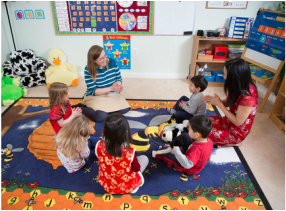Dual Immersion

Dual immersion is a two-way language immersion model that is structured so that both the English-dominant and the second-language-dominant students are able to build their proficiencies in both languages over time.
A&D Stars brings together three groups of families into our school community. Different groups come with different language experiences and expectations, and thus have different needs.
Our first group of our preschoolers have native Mandarin proficiency. They learn English while continuing their home language education in a school context, and provide a model for the non-Chinese speaking children.
Our second group of preschoolers have some Mandarin experience, mostly from having one parent or grandparent who speaks to them in Mandarin Chinese. They benefit from having more experienced speakers to communicate with, so that they build on what they already know.
Our third group of preschoolers do not have prior exposure to Mandarin. They get to acquire a second language and provide a native English speaking model for the non-English speaking children.
The children will spend 80% of their instructional day in Mandarin Chinese and the remaining 20% in English. The teachers, who are native speakers of each language, collaborate to ensure that children acquire not only strong Mandarin Chinese skills but also the fundamentals of English literacy.
A&D Stars brings together three groups of families into our school community. Different groups come with different language experiences and expectations, and thus have different needs.
Our first group of our preschoolers have native Mandarin proficiency. They learn English while continuing their home language education in a school context, and provide a model for the non-Chinese speaking children.
Our second group of preschoolers have some Mandarin experience, mostly from having one parent or grandparent who speaks to them in Mandarin Chinese. They benefit from having more experienced speakers to communicate with, so that they build on what they already know.
Our third group of preschoolers do not have prior exposure to Mandarin. They get to acquire a second language and provide a native English speaking model for the non-English speaking children.
The children will spend 80% of their instructional day in Mandarin Chinese and the remaining 20% in English. The teachers, who are native speakers of each language, collaborate to ensure that children acquire not only strong Mandarin Chinese skills but also the fundamentals of English literacy.
